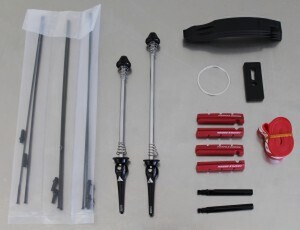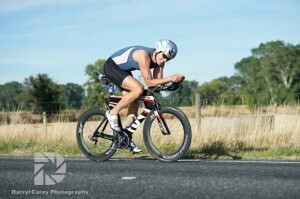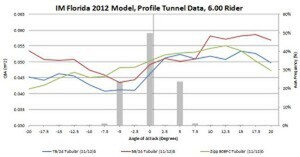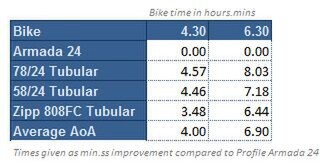Profile Design have been beavering away developing new race wheels for the last couple of years. I was fortunate enough to receive one of the first production sets in February prior to the Global release and have spent quite a bit of time on them.
Even better – I’ve got aero data so I can detail exactly how well they perform (because I’m obviously not going to write a review just based on fluffy concepts like ‘feel’).
Attempt to show the rim curvatureFirstly – in the interests of full disclosure – I have these wheels because I’ve been engaged by Profile to analyse their wind tunnel data and apply it to real world situations. I was not involved in the development of the wheels though I did help them develop their design methodology a few years ago. My reaction on seeing the performance data was that they needed to send me a set ASAP. Which they did. Which made me happy.
As an overview of the range:
Currently two depths – 58mm and 78mm
One width – 24mm (hence the appellation ‘TwentyFour’)
Tubular and full Carbon Clincher models
One speed = fast
You can read the development story here. Suffice to say – they put effort into not only the aerodynamics but also the braking performance, construction methods and assembly process.
I’ll first discuss the wheels and the ride experience, then move on to the important stuff (aero)…
Installation
I’m not going to go all dcrainmaker on the unboxing – they come in a wheel box and include an accessory pack (which I did manage to take a picture of).
I like the inclusion of spare spokes in case something untoward happens, certain other companies struggle to even make spare spokes available aftermarket (cough… Fulcrum). Tyre levers also a nice touch.
The skewers are a nice minimalist design weighing in at 72g for the pair. The valve extenders work well and are 6g for the pair.
I haven’t used the rim tape – I fitted veloplugs as is my wont. Obviously the tape matches the width of the rim (adds 20g per wheel).
The included brake pads are sized the same as stock Magura RT pads so the swap was quite easy. In fact, the whole installation process was easy – tyres went on with no fuss and we were quickly set to go. No clearance issues between the wide rims and the chainstays of the Cervelo P5.
Freehubs are Shimano/SRAM 11 or 10 speed compatible.
The Continental tyres I fitted perfectly matched the width of the brake track – giving me reasonable confidence that they wouldn’t be harming the performance of the rims.
The Ride
Actually not a great deal to say about this aspect – I don’t notice any great difference from my normal Campag Zonda training wheels (which I like). They behave exactly as wheels should – nice amount of stiffness (massive rim cross section doesn’t hurt there) and a general feeling of solidity.
Braking with the supplied pads is also exactly as it should be – that is – I notice little difference from normal pads with Aluminium rims. It helps that my hydraulic brakes have plenty of modulation and stopping power, so there may be a fair amount of unused capacity normally. Even if that is the case – my experience with braking has been entirely predictable and confidence inspiring. I haven’t used the wheels in any worse conditions than light rain but have had no issues in that instance either. I haven’t had any cause for prolonged braking to be able to test the effect of heat build-up so can’t comment on that.
Handling in cross winds is likewise confident – occasional twitches in gusty conditions but the effect of wind is in general quite muted.
Obviously a major part of the experience with race wheels is having nice tyres & tubes to maximise performance and they make more of a difference to speed and feel than the wheels themselves. That said – I really like riding these wheels. I’ve not had any nasty surprises or issues and they do ‘feel’ fast.
Aerodynamics
I will open this section by discussing my previous wheels – I was still using the pre-Firecrest Zipp 808 and 1080 (clinchers) as Zipps wind tunnel data showed them to be faster in the conditions I care about. Firecrests would only have an advantage if I was having a bad day (in which case wheels are the least of my problems) or it was super windy. Zipp, like many other brands, optimises their wheel performance for high yaw situations – Time Triallists and Front of Pack triathletes should be more interested in low yaw performance for most events.
So when the Profile data came through showing that they had focussed on the low yaw region (with a corresponding trade off at high yaw) I was instantly ready to make the switch (I’m not particularly brand loyal – I’m speed loyal – will go to whatever is fastest). Profile have given permission for me to show their data here which is quite handy.
The testing was performed at the FASTER Wind Tunnel and the wheels were fitted to a Scott Plasma II so that frame interactions (like rear wheel shielding) are factored into the results – making the output much more relevant to the real world than wheel only testing. All wheels tested with the same model of tyres (Vittoria Corsa Tubulars & Clinchers).
The model takes account of aero performance and weight differences between the wheels.
I’m not going to discuss differences in grams of drag – instead I’ll go straight into looking at the output from modelling – interpreting the data into figures that are more easily understood.
Ironman Florida Model
First off – the IMFL model (that I’ve discussed previously) from 2012. It should be noted that the conditions for this race were very favourable to products with good low yaw performance (like the Cervelo Bike discussed in the link above) so it’s an ideal scenario for the Profile wheels.
The graphs to the right show the windtunnel data for the listed wheels plotted with the yaw distribution. Florida 2012 was notable for no wind in the first couple of hours – allowing all riders to accumulate a lot of time near zero yaw. Then the winds picked up as the day progressed – thus riders who were out on the course longer started to spend time in higher yaw zones.
What is noticeable is that both depths of the Profile Twentyfour series wheels beat the Zipps at low yaw. And even for the 6hr rider the majority of their time is spent in the sweet spot for both the 58 & 78 Profile models.
This table shows the time benefit compared to Profiles Armada training wheel. Note that for the 4hr rider the Profile 78s offer a 51% greater speed advantage than the 808s, but for the 6.30hr rider that benefit drops to 31% – reflecting that the slower rider is moving more towards the zone in which the 808 is superior.
Also, it’s worth noting that the slower riders get more benefit, both as time and percentage, than the faster riders. This is because most wheels are quite close in performance at low yaw but the deep carbon models really outperform shallow training wheels as the yaw increases. Once again showing that the oft repeated myths about needing to average a certain speed to get the benefit of fast kit are rubbish.
Ironman Hawaii Model
Windy from the start and hillier (so the weight difference matters more) than IMFL. However, in 2012 the conditions were such that most riders were still spending most of their time in the sub 15° yaw region, leading to the table below.
It’s clear that the crossover point for the 58/TwentyFour wheels vs the 808s is around 5.30hrs. And that the 808s are narrowing the gap on the 78/TwentyFours as the times slow down. What is a little startling is just how much advantage there is for Front of Pack riders. The performance of the 58mm depth is particularly appealing for a course like Kona noted for gustiness.
Unfortunately I can’t find the analysis I did of Kona 2010 and I’m running out of time to finish this article (will try to come back later to add to this). While 2011/2012 were very much in favour of the Profile wheels I recall the 2010 conditions being much more in favour of the high yaw performance of Zipps.
At this point I’d like to emphasise that we can no longer talk about one product being fastest – all the leading edge brands have to decide which conditions they wish to focus on and make trade-offs in other areas. Profile have chosen to excel in low yaw conditions – which is a decision that I agree with – but it should be noted that this is not always the optimum. Every athlete needs to consider what they’re most likely to be facing when they choose their equipment.
Time for some local flavour:
Ironman New Zealand Model
I can’t find good weather history for Taupo at the moment, so I have to caution that this analysis is a little hamstrung by having to take weather data from Tokoroa for the 2013 IMNZ. I used the temperature data from my Garmin but have no means of telling whether the wind strengths are accurate.
With that caveat in mind – the data I have gives the results to the left – still showing an advantage for the Profile Wheels. We would see the same for nearly every edition of the Tauranga Half as the high speeds on that course lead to low yaw.
Taupo throws up some rather windy conditions but even so – at race speeds Profile will have the edge for most riders on most days.
Time Trialling
In the race of truth the distances are much shorter than an IM (unless you’re in the UK doing 100 milers or in NZ doing the Midsummer Madness). With that lesser duration you tend not to get the big spread of yaw – you will be focussed on a tight band unless it is a loop course and very windy.
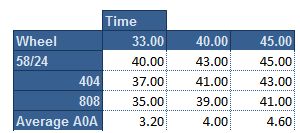
One of the athletes Profile sponsor in Europe is a top Master Time Triallist so they asked me to model one of his races. To the right is a table based on the 2012 Masters Games in Pietermaritzburg – the times are seconds advantage vs the Profile Armada training wheels.
Note that this was a different day in the tunnel for Profile compared to the data above and the 78/TwentyFour wasn’t tested on that occasion. Quite interesting that Profiles testing showed the 404FC to be faster than the 808FC at low yaw – leading to the results at right.
Much narrower differences when we’re looking at a 25km, 33min race. Though I noticed a couple of events at last years masters worlds where a few seconds was the difference between winning and the alternative.
Conclusion
If I were to find fault with Profiles methodology it would be the lack of a mannequin on the bike to integrate leg shielding effects into the results, but I’m not aware of any wheel brand doing that yet. As far as I can tell the testing was robust and therefore credible. Based on the data and the positive experience I’d had training on the wheels I chose to forgo using a Disc rear wheel at IMNZ – preferring the ride quality of these wheels and confident that I’d be making little or no sacrifice in speed. Unfortunately food poisoning leading in to the race meant that I did not generate any personal proof of the wheels performance but that is no reflection on any of my equipment.
What I’d like to see from Profiles next round of testing is a comparison to a disc wheel and more information around tyre selection – several brands have shown how crucial this can be and it is now an important part of your equipment choices.
The wheels are available (only the 58mm depth) as of this week (beginning of September 2013) in New Zealand and retail for $2799 & $2999 for Tubulars and Clinchers respectively. Which is my final point in what makes them an impressive wheel – all the performance and quality detailed above at retail prices lower than Zipps wholesale.
Let me know if you want some…


